The Influence of Different Focusing Currents on the Microstructure Evolution and Wear Properties of a Scanning Electron Beam Modified Inconel 625 Nickel Base Alloy Surface
Abstract
:1. Introduction
2. Experimental Materials and Processes
2.1. Sample Preparation
2.2. Electron Beam Surface Strengthening Treatment
2.3. Friction and Wear Test
2.4. Microstructure Characterization Test
3. Results
3.1. Macromorphology of Electron Beam Cladding
3.2. Microstructure Evolution
3.3. Macroscopic Appearance of Wear Scar and Wear Volume
4. Discussion
4.1. Effect of Different Focusing Currents on Microstuction
4.2. Effects of Different Focusing Currents on Texture
4.3. Observation and Analysis of Wear Morphology
5. Conclusions
- (1)
- The austenite grains of the original sample after hot deformation mainly showed equiaxed grains with an average grain size of 18 μm, and there were a large number of twins. The grain orientation was mainly green {101} crystal plane and purple {111} crystal plane. After electron beam scanning, the grains of the original sample grew up, showing long strip grains and island grains. The melting zone was arc-shaped under a 720 mA to 760 mA focusing current. Under a 700 mA focused current, the melting zone presented an inverted convex shape. This was due to the small focusing current, which led to excessive electron beam energy breakdown of the substrate. The austenite grain orientation in the melting region was mainly red {001} crystal plane and green {101} crystal plane.
- (2)
- The wear volume of the original sample was the largest, 0.1929 , and the wear rate was also the largest, 1.9292. After the electron beam strengthening treatment, the sample’s wear improved. With the increase in focusing current, the wear resistance decreased at first and then increased. At a 720 mA focusing current, the wear volume reached the minimum value of 0.1415 mm3, and the wear rate was also the minimum, which was 1.4153 . Compared with the original sample, the 720 mA wear volume decreased by 26.64%. This may be related to the columnar crystals produced in the melting area. When a 720 mA focusing current was applied, relatively fine columnar crystals were found in the melting zone. After the electron beam scanning treatment, the fatigue wear, adhesive wear, and oxidation wear of the samples were improved to varying degrees.
- (3)
- The original Inconel 625 samples were mostly S {123}<634> and Brass {110}<112>. S {123}<634> was the most common, accounting for 26.4% of them. The texture types of the melting zone in Inconel 625 had changed to some extent under different focusing currents. However, they eventually all formed a typical cubic texture, the Cube {001}<100> texture and the S {123}<634> texture (the content was about 10%), accompanied by a small amount of Brass {110}<112> and Copper {112}<111> textures. The melting area contained 14.7% Cube {001}<100> texture under a 720 mA focusing current.
Author Contributions
Funding
Institutional Review Board Statement
Informed Consent Statement
Data Availability Statement
Acknowledgments
Conflicts of Interest
References
- Paul, C.P.; Ganesh, P.; Mishra, S.K.; Bhargava, P.; Negi, J.; Nath, A.K. Investigating laser rapid manufacturing for Inconel-625 components. Opt. Laser Technol. 2007, 39, 800–805. [Google Scholar] [CrossRef]
- Zhang, Y.; Jiang, Y.; Hu, X. Microstructure and high temperature creep properties of laser welded joints of Inconel 625 alloy formed by selective laser melting. J. Weld. 2020, 41, 78-84, 101–102. [Google Scholar]
- Kulka, M.; Makuch, N.; Dziarski, P. A study of nanoindentation for mechanical characterization of chromium and nickel borides’ mixtures formed by laser boriding. Ceram. Int. 2014, 40, 6083–6094. [Google Scholar] [CrossRef]
- Ueda, N.; Mizukoshi, T.; Demizu, K.; Sone, T.; Ikenaga, A.; Kawamoto, M. Boriding of nickel by the powder-pack method. Surf. Coat. Technol. 2000, 126, 25–30. [Google Scholar] [CrossRef]
- Deng, T.; Zheng, Z.; Li, J.; Xiong, Y.; Li, J. Surface polishing of AISI 304 stainless steel with micro plasma beam irradiation. Appl. Surf. Sci. 2019, 476, 796–805. [Google Scholar] [CrossRef]
- Qu, W.; Yang, B.; Liu, Y.; Yuan, K.; Kong, H.; Song, Y. Development and status quo of laser surface processing technology. Hot Work. Proc. 2017, 46, 38–41. [Google Scholar]
- Wang, J. Microstructure and Properties of 304 Austenitic Stainless Steel Modified by Electron Beam; Chongqing University of Technology: Chongqing, China, 2019; p. 8. [Google Scholar]
- Won, S.J.; Kim, H.S. Effects of laser parameters on morphological change and surface properties of aluminum alloy in masked laser surface texturing. J. Manuf. Proc. 2019, 48, 260–269. [Google Scholar] [CrossRef]
- Sharma, S.K.; Biswas, K.; Majumdar, J.D. Wear behaviour of Electron beam surface melted Inconel 718. Procedia Manuf. 2019, 35, 866–873. [Google Scholar] [CrossRef]
- Yang, S.; Wang, Y.; Shen, D.; Dong, W.; Wang, F. Research status onelectron beam of non-ferrous alloy. Mater. Rep. 2014, 28, 60–63. [Google Scholar]
- Liu, J.; Zou, Z.; Su, B. Reject High-Energy Beam Heat Treatment, 1st ed; China Machine Press: Beijing, China, 1997. [Google Scholar]
- Cai, J.; Lv, P.; Zhang, C.L.; Wu, J.; Li, C.; Guan, Q.F. Microstructure and properties of low carbon steel after surface alloying induced by high current pulsed electron beam. Nucl. Instrum. Methods Phys. Res. Sect. B Beam Interact. Mater. At. 2017, 410, 47–52. [Google Scholar] [CrossRef]
- Yang, S.; Guo, Z.; Zhao, L.; Guan, Q.; Zhao, L.; Liu, Y. Microstructures and corrosion resistance of Zircaloy-4 after surface alloying with copper by high-current pulsed electron beam. Appl. Surf. Sci. 2020, 501, 144222. [Google Scholar] [CrossRef]
- Vivek, P.; Akash, S.; James, H.; Mike, C.; David, H.; Wayne, H. Electron beam welding of In-conel 718. Procedia Manuf. 2020, 48, 428–435. [Google Scholar]
- Zhang, J.; Guan, Z. Electron beam welding process of Incoloy 825 nickel base superalloy and analysis of joint microstructure and mechanical properties. J. Weld. 2020, 41, 32–37. [Google Scholar]
- Ivanov, Y.F.; Ozur, G.E. Pulsed electron-beam treatment of WC–Ti C–Co hard-alloy cutting tools: Wear resistance and microstructural evolution. Surf. Coat. Technol. 2000, 125, 251–256. [Google Scholar] [CrossRef]
- Shu, D.; Cui, X.; Li, Z.; Sun, J.; Wang, G.; Si, W.; Dai, S.; Chen, X. Microstructure and friction and wear properties of nano-WC reinforced Ni-based coating. Adv. Laser Optoelectron. Progress. 2020, 57, 1–16. [Google Scholar]
- Kim, J.; Kim, J.; Kang, E.; Park, H.W. Surface modification of the metal plates using continuous electron beam process (CEBP). Appl. Surf. Sci. 2014, 311, 201–207. [Google Scholar] [CrossRef]
- Fu, Y.; Hu, J.; Shen, X.; Wang, Y.; Zhao, W. Surface hardening of 30CrMnSiA steel using continuous electron beam. Nucl. Instrum. Methods Phys. Res. Sect. B Beam Interact. Mater. At. 2017, 410, 207–214. [Google Scholar] [CrossRef]
- Wang, S.; Li, H.; Xu, H.B.; Chen, Y. Research progress on surface alloying based on high energy beams. South. Met. 2013, 5, 1–4+9. [Google Scholar]
- Zhang, F.; Wang, F.; Hao, J.; Ma, Y.; Ma, A. Three-beam surface modification technology application and development trends. Hebei Agric. Univ. J. 2003, 26, 260–263,266. [Google Scholar]
- Nippes, E.F. The weld heat-affected zone. Weld. J. 1959, 38, 15–185. [Google Scholar]
- Savage, W.; Nippes, E.; Szekeres, E. Study of weld interface phenomena in a low alloy steel. Weld. J. 1976, 55, 260. [Google Scholar]
- St Węglowski, M.; Błacha, S.; Phillips, A. Electron beam welding—Techniques and trends—Review. Vacuum 2016, 130, 72–92. [Google Scholar] [CrossRef]
- Zhu, Z.; Ma, X.; Mi, G.; Wang, C. Electron microscopy study of laser welded GH909 superalloy joint—ScienceDirect. J. Mater. Res. Technol. 2020, 9, 15525–15536. [Google Scholar] [CrossRef]
- Schwartz, A.J.; Kumar, M.; Adams, B.L.; Field, D.P. Electron Backscatter Diffraction in Materials Science; Springer: New York, NY, USA, 2009. [Google Scholar] [CrossRef]
- Babaniaris, S.; Ramajayam, M.; Jiang, L.; Varma, R.; Langan, T.; Dorin, T. Effect of Al3(Sc,Zr) dispersoids on the hot deformation behaviour of 6 xxx-series alloys: A physically based constitutive model. Mater. Sci. Eng. A 2020, 793, 139873. [Google Scholar] [CrossRef]
- Gavard, L.; Montheillet, F.; Coze, J.L. The effect of purity on dynamic recrystallization in austenitic stainless steels. Mater. Trans. JIM 2007, 41, 113–115. [Google Scholar] [CrossRef] [Green Version]
- Song, Y.; Li, Y. Hot deformation and recrystallization behavior of a new nickel-base superalloy for ultra-supercritical applications8. J. Mater. Res. Technol. 2022, 19, 4308–4324. [Google Scholar] [CrossRef]
- He, L.; Zhang, C. Study on wear resistance of as cast high chromium cast iron in columnar grain zone. Mech. Eng. Mater. 1998, 22, 4. [Google Scholar]
- Mu, J.; Wang, H.; Qin, B.; Zhang, Y.; Chen, L.; Zeng, C. Improved wear and corrosion resistance of biological compatible TiZrNb films on biomedical Ti6Al4V substrates by optimizing sputtering power. Surf. Coat. Technol. 2021, 428, 127866. [Google Scholar] [CrossRef]
- Zhao, G.; Sun, M.; Li, J.; Li, H.; Ma, L.; Li, Y. Study on quasi-in-situ tensile microstructure evolution law of 5052-O aluminum alloy based on EBSD. Mater. Today Commun. 2022, 33, 104572. [Google Scholar] [CrossRef]
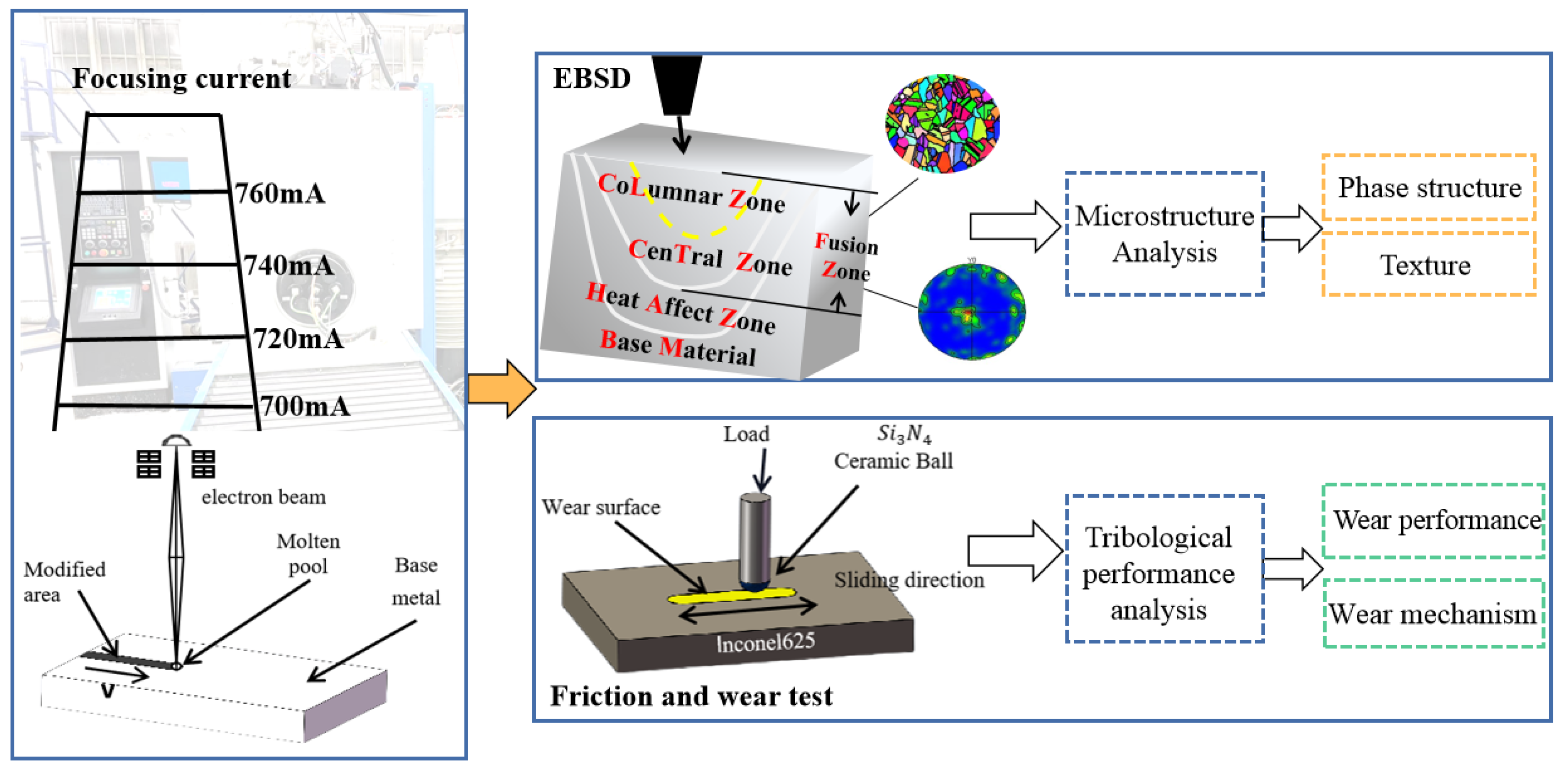

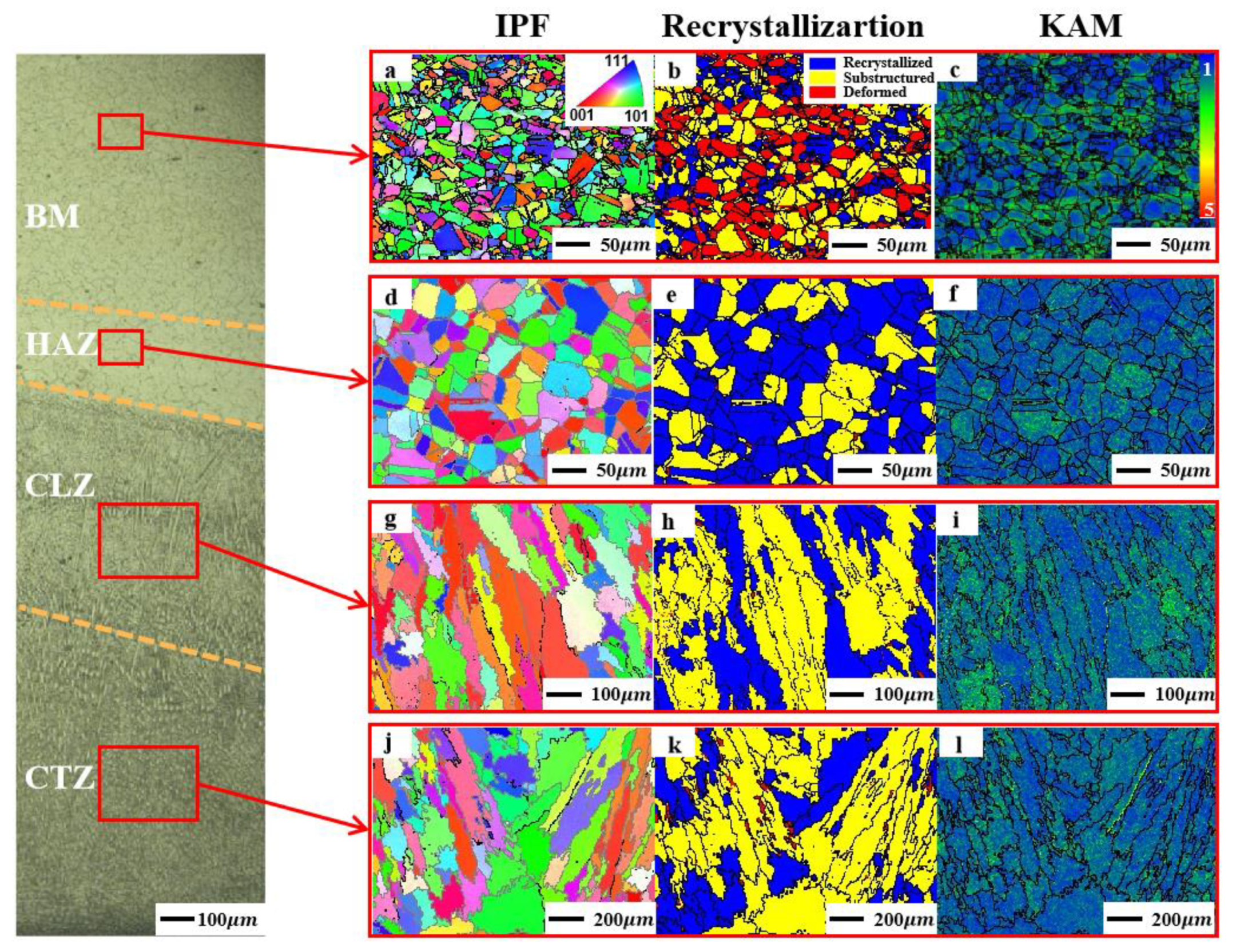

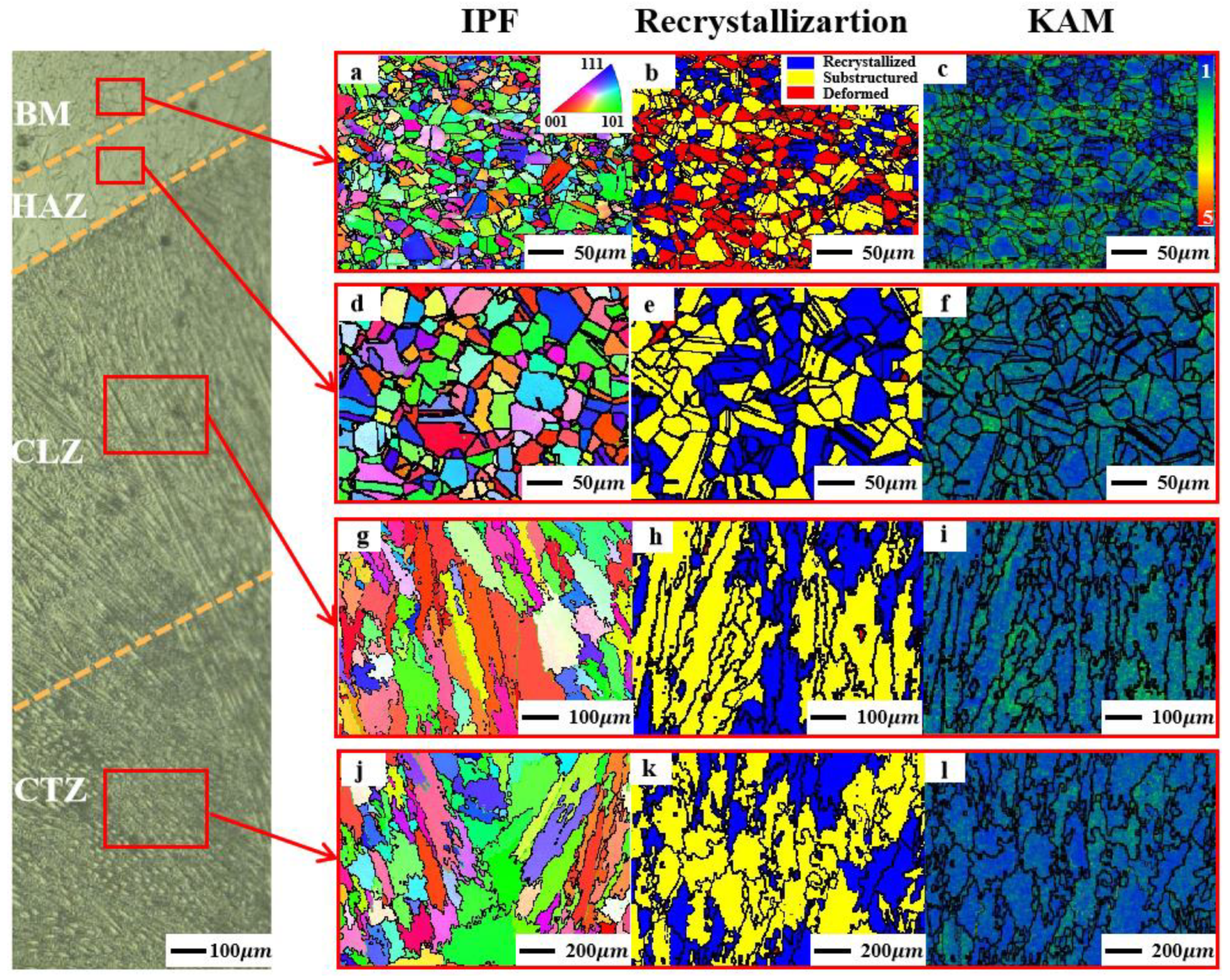
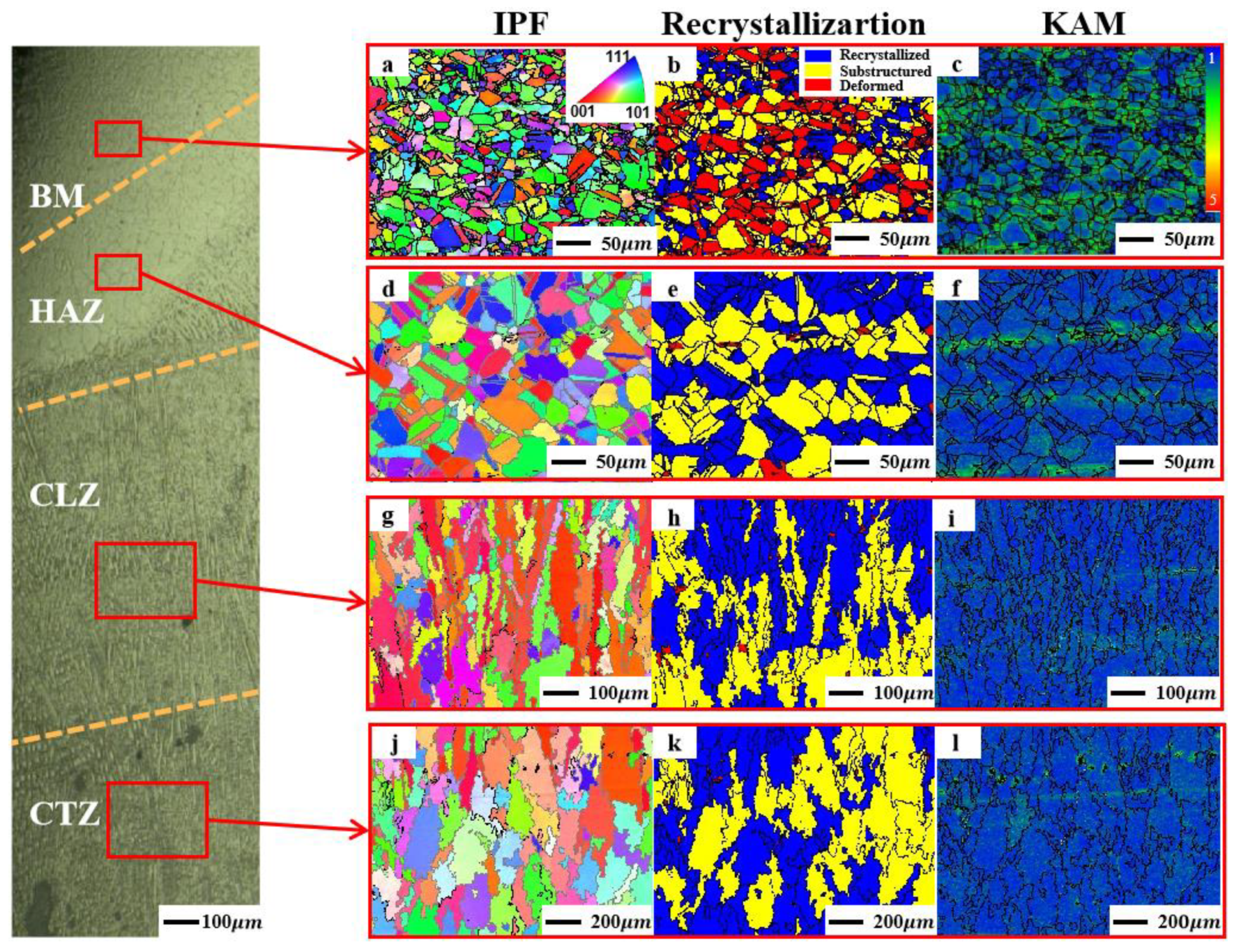

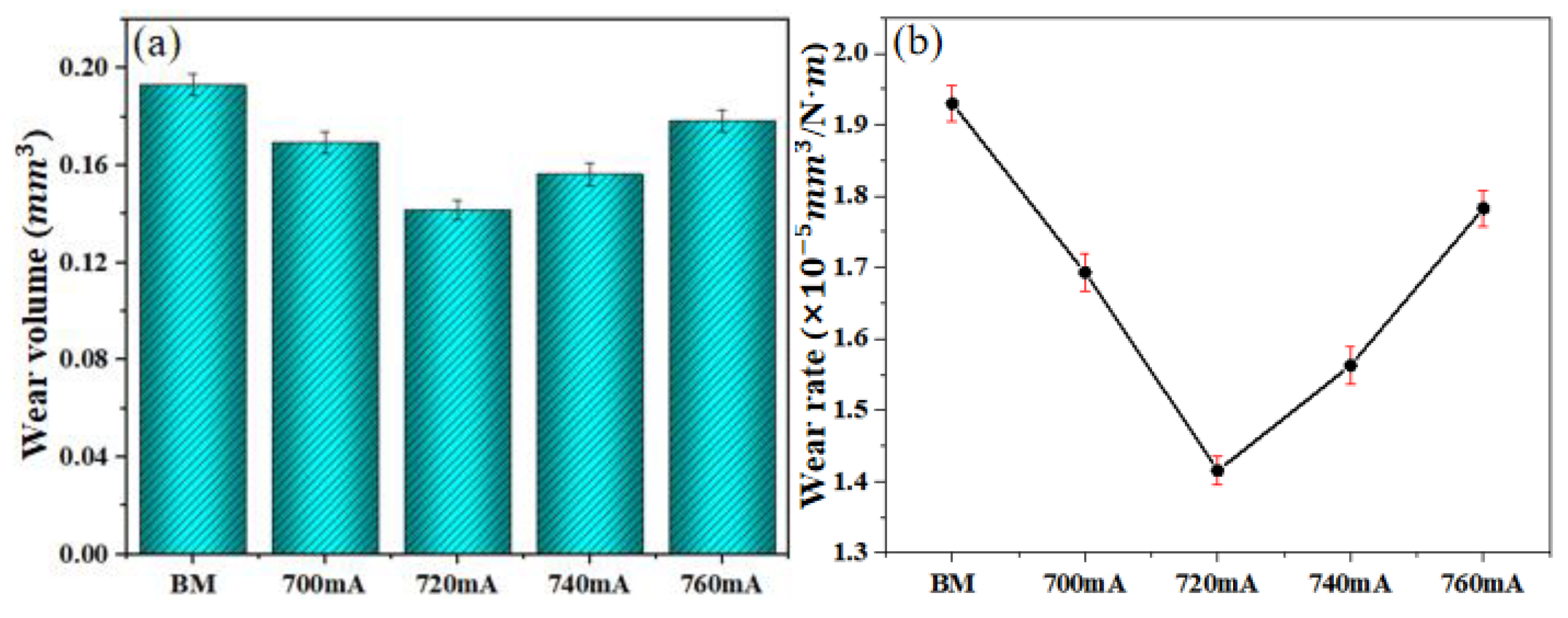



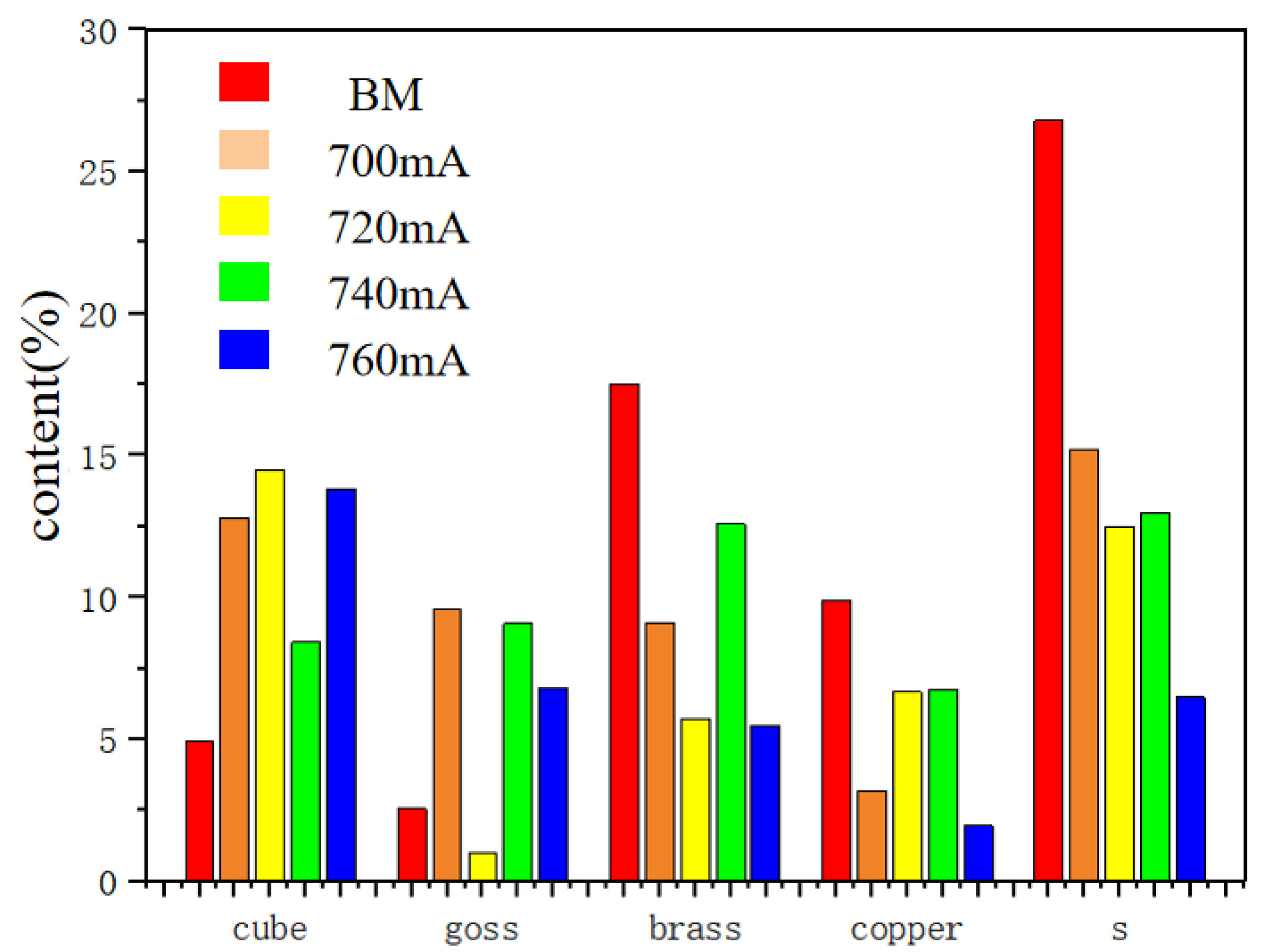
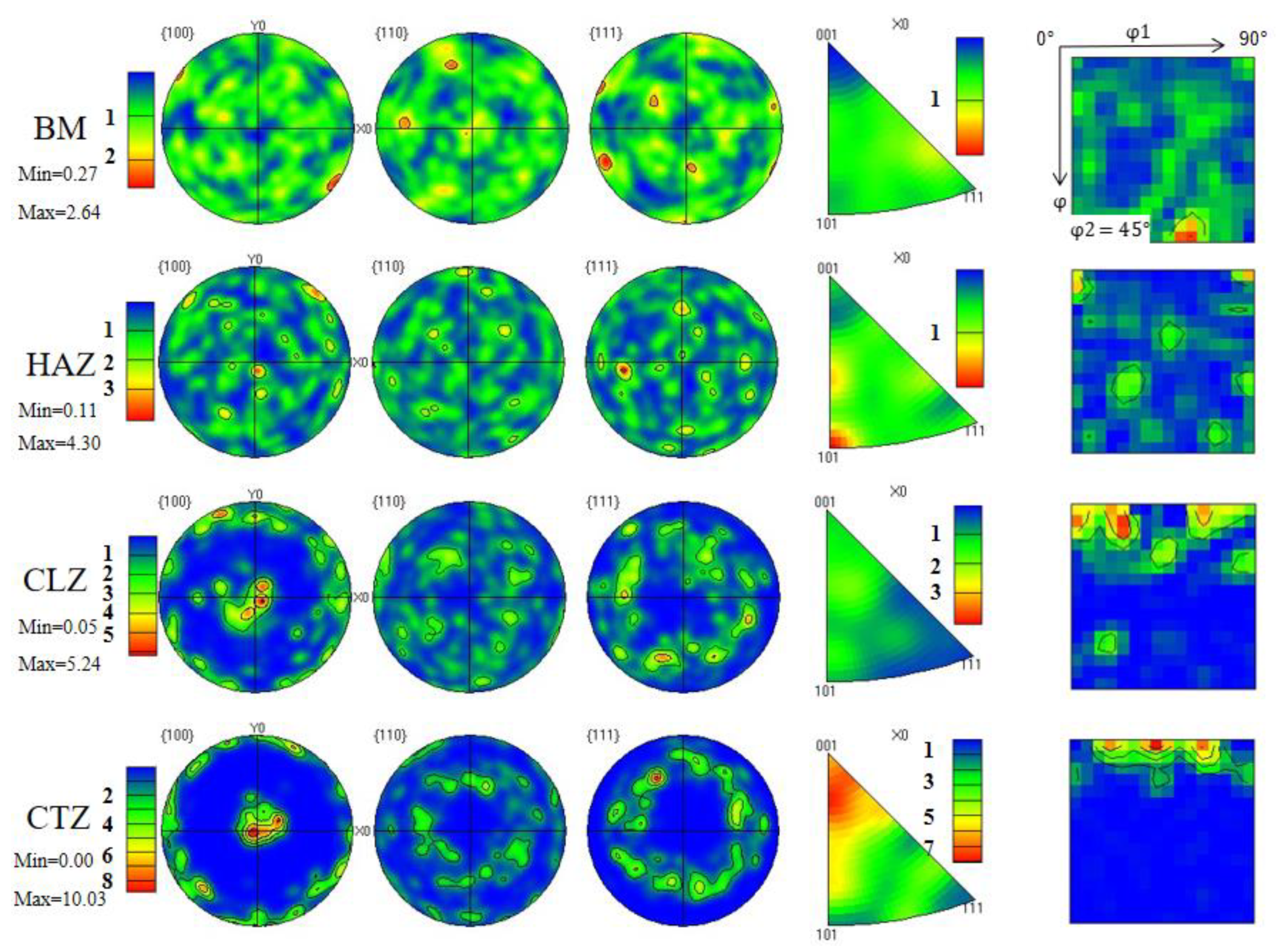
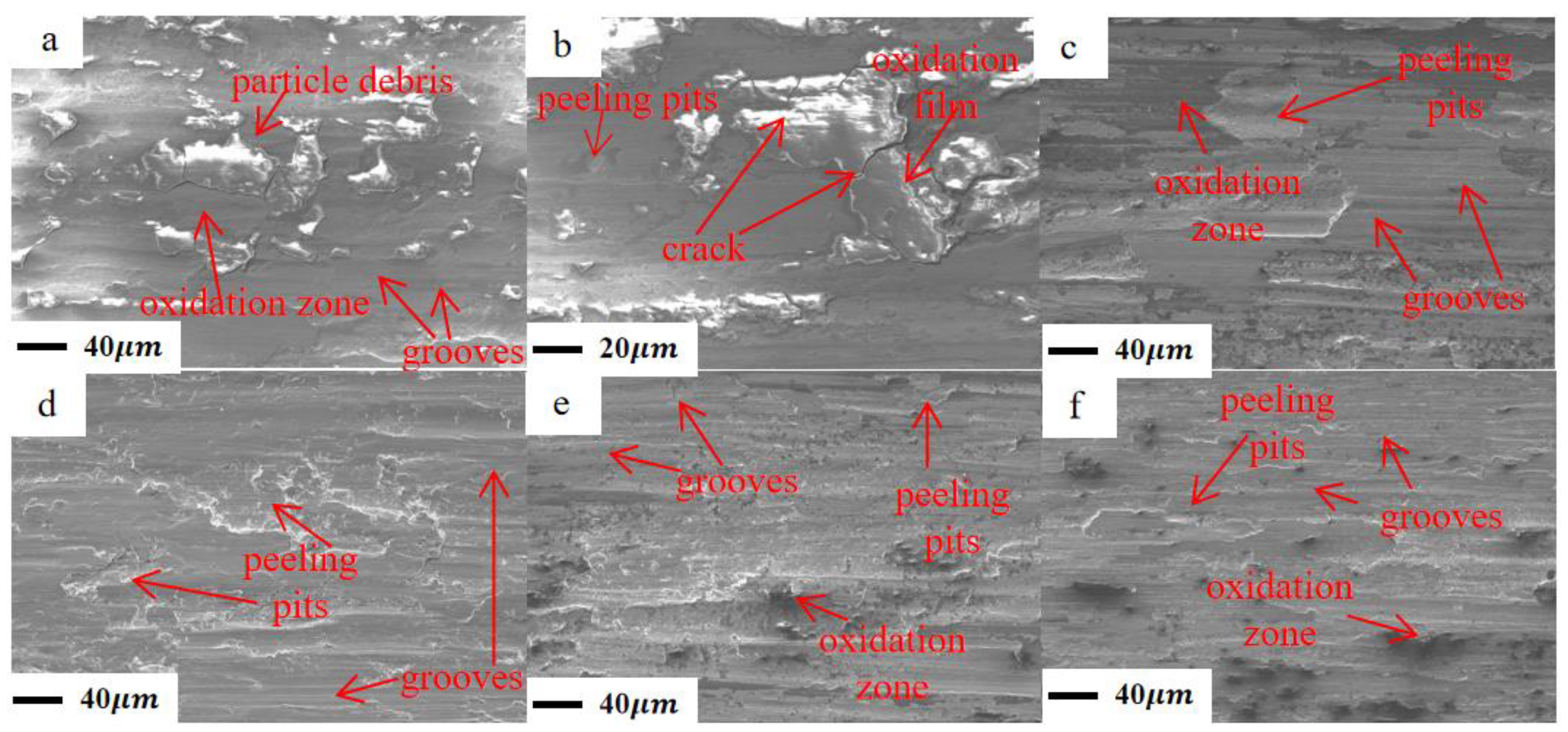

| Ni | Cr | Mo | Nb | Fe | C | N | Ti | Al |
|---|---|---|---|---|---|---|---|---|
| 61.9 | 22.8 | 8.4 | 3.4 | 2.2 | 0.9 | 0.1 | 0.1 | 0.1 |
| Beam Current | Focusing Current | Accelerating Voltage | Scanning Speed |
|---|---|---|---|
| 10 mA | 700 mA | 60 KV | 240 mm/min |
| 10 mA | 720 mA | 60 KV | 240 mm/min |
| 10 mA | 740 mA | 60 KV | 240 mm/min |
| 10 mA | 760 mA | 60 KV | 240 mm/min |
Disclaimer/Publisher’s Note: The statements, opinions and data contained in all publications are solely those of the individual author(s) and contributor(s) and not of MDPI and/or the editor(s). MDPI and/or the editor(s) disclaim responsibility for any injury to people or property resulting from any ideas, methods, instructions or products referred to in the content. |
© 2023 by the authors. Licensee MDPI, Basel, Switzerland. This article is an open access article distributed under the terms and conditions of the Creative Commons Attribution (CC BY) license (https://creativecommons.org/licenses/by/4.0/).
Share and Cite
Li, J.; Yao, J.; Zhao, G.; Li, H.; Li, Y.; Liu, J. The Influence of Different Focusing Currents on the Microstructure Evolution and Wear Properties of a Scanning Electron Beam Modified Inconel 625 Nickel Base Alloy Surface. Crystals 2023, 13, 325. https://doi.org/10.3390/cryst13020325
Li J, Yao J, Zhao G, Li H, Li Y, Liu J. The Influence of Different Focusing Currents on the Microstructure Evolution and Wear Properties of a Scanning Electron Beam Modified Inconel 625 Nickel Base Alloy Surface. Crystals. 2023; 13(2):325. https://doi.org/10.3390/cryst13020325
Chicago/Turabian StyleLi, Juan, Jiaye Yao, Guanghui Zhao, Huaying Li, Yugui Li, and Jie Liu. 2023. "The Influence of Different Focusing Currents on the Microstructure Evolution and Wear Properties of a Scanning Electron Beam Modified Inconel 625 Nickel Base Alloy Surface" Crystals 13, no. 2: 325. https://doi.org/10.3390/cryst13020325
APA StyleLi, J., Yao, J., Zhao, G., Li, H., Li, Y., & Liu, J. (2023). The Influence of Different Focusing Currents on the Microstructure Evolution and Wear Properties of a Scanning Electron Beam Modified Inconel 625 Nickel Base Alloy Surface. Crystals, 13(2), 325. https://doi.org/10.3390/cryst13020325









